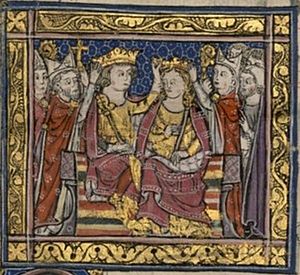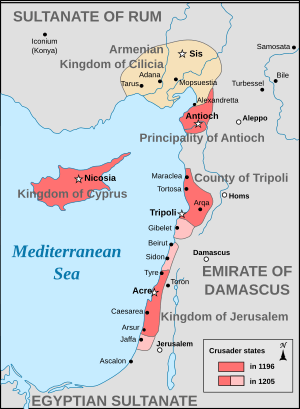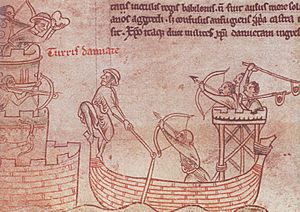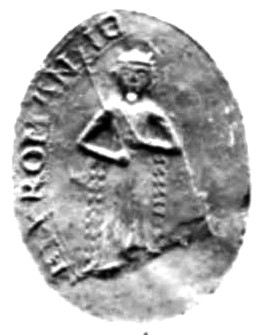John of Brienne facts for kids
Quick facts for kids John of Brienne |
|
|---|---|

Coronation of John and his first wife, Maria (from a 13th-century miniature)
|
|
| Latin Emperor of Constantinople together with Baldwin II |
|
| Reign | 1229–1237 |
| Coronation | 1231 |
| Predecessor | Baldwin II |
| Successor | Baldwin II |
| King of Jerusalem together with Maria (1210–1212), and with Isabella II (1212–1225) |
|
| Reign | 1210–1225 |
| Coronation | 3 October 1210 |
| Predecessor | Maria |
| Successor | Isabella II and Frederick |
| Count of Brienne | |
| Reign | 1205/06–1221 |
| Predecessor | Walter III |
| Successor | Walter IV |
| Born | c. 1170 |
| Died | 19–23 March 1237 (aged 66–67) Constantinople |
| Burial | Hagia Sophia, Constantinople (now Istanbul, Turkey) |
| Spouse |
Stephanie of Armenia
(m. 1214; died 1220) |
| Issue |
|
| House | Brienne |
| Father | Érard II, Count of Brienne |
| Mother | Agnes of Montfaucon |
| Religion | Roman Catholic |
John of Brienne (born around 1170 – died March 27, 1237) was an important leader in the Middle Ages. He served as King of Jerusalem from 1210 to 1225. Later, he became the Latin Emperor of Constantinople from 1229 to 1237. John was the youngest son of Erard II, a rich nobleman from Champagne, France.
John was originally expected to join the church. However, he chose to become a knight instead. Around 1200, he owned small lands in Champagne. After his brother Walter III died, John managed the County of Brienne for his young nephew, Walter IV.
The nobles of the Kingdom of Jerusalem asked John to marry their queen, Maria. With the approval of the French king and the Pope, John traveled to the Holy Land. He married Queen Maria, and they were crowned in 1210. After Maria passed away in 1212, John became the ruler for their baby daughter, Isabella II.
John was a key leader in the Fifth Crusade. This was a major military campaign to reclaim the Holy Land. He led the crusader army and helped capture Damietta in Egypt in 1219. However, the crusade ultimately failed in 1221.
John was the first King of Jerusalem to visit Europe. He traveled to many countries, including Italy, France, and England, to ask for help for the Holy Land. In 1225, he arranged for his daughter Isabella to marry Holy Roman Emperor Frederick II. This marriage ended John's rule over the Kingdom of Jerusalem.
Later, John served the Pope, leading an army against Frederick II. In 1229, he was chosen to be the senior co-ruler of the Latin Empire with Baldwin II. He was crowned in Constantinople in 1231. In 1235, his capital, Constantinople, was attacked. John bravely led the city's defense during a long siege. He died in 1237 as a Franciscan friar.
Contents
Early Life and Family Background
John was the youngest of four sons. His parents were Count Erard II of Brienne and Agnes of Montfaucon. Historians believe John was born sometime after 1168, likely in the 1170s.
His father wanted John to become a priest. However, John preferred a different path. Stories say he ran away and became a knight. He gained a reputation for his skills in tournaments and battles. John was known for his physical strength.
John's father died in the Holy Land in 1191 during the Third Crusade. His oldest brother, Walter III, became the Count of Brienne. John was mentioned in his brother's official papers around 1192. He owned several villages in the County of Champagne by 1200.
In 1205, Walter III died in southern Italy. His wife gave birth to a son, Walter IV, after his death. John then took on the role of count of Brienne. He managed the county for his young nephew from 1205 or 1206. As a powerful noble, John often visited the court of Blanche of Navarre. She ruled Champagne while her son, Theobald IV, was still a child.
The nobles of Jerusalem needed a husband for their queen, Maria. They asked the French king, Philip II, to choose someone. Philip II suggested John. John accepted the offer with the king's blessing. He then visited Pope Innocent III in Rome. The Pope gave 40,000 marks to help defend the Holy Land. He said John could only spend the money with the agreement of other church and military leaders.
King of Jerusalem
Becoming King

John arrived in Acre on September 13, 1210. The next day, he married Queen Maria. They were crowned in the Cathedral of Tyre on October 3. The peace treaty between Jerusalem and the Ayyubid sultan Al-Adil I had ended. While John and Maria were being crowned, Al-Adil's son attacked the area around Acre. After the coronation, John raided nearby Muslim towns in return.
About 300 French knights came with John to the Holy Land. However, no other powerful nobles joined him. They preferred to fight in other wars in France. John's cousin, Walter of Montbéliard, joined him later. Walter led a sea attack on Egypt. After most of the French crusaders left, John made a new peace treaty with Al-Adil in 1211. He also asked Pope Innocent to call for a new crusade.
Challenges and New Marriage
Maria died in late 1212 after giving birth to their daughter, Isabella. Her death caused a legal problem. John of Ibelin, who had ruled Jerusalem before John, questioned John's right to continue as king. John asked the Pope for help. In 1213, Pope Innocent confirmed John as the rightful ruler. He said John could rule on behalf of his baby daughter. Most of the Jerusalemite nobles supported John.
John's relationship with Hugh I of Cyprus was difficult. Hugh even imprisoned John's supporters in Cyprus. John also got involved in a conflict in Antioch. He sided with Bohemond IV of Antioch against Leo I, the King of Cilician Armenia. However, John and Leo later made peace. In 1214, John married Leo's oldest daughter, Stephanie. She brought a large dowry of 30,000 bezants. The Pope urged John and other leaders to settle their differences before the Fifth Crusade arrived.
The Fifth Crusade
Pope Innocent called for the Fifth Crusade in 1213. Its main goal was to take back Jerusalem. The first crusader troops arrived in Acre in September 1217. Andrew II of Hungary and his army followed. Hugh I of Cyprus and Bohemond IV of Antioch also joined. However, many crusaders soon went home because there wasn't enough food.
A meeting was held to decide who would lead the army. Andrew II thought he should be in charge, but John and other leaders disagreed. The crusaders raided nearby Muslim lands for food. In December 1217, John tried to capture a fortress on Mount Tabor, but he failed. This made the enemy feel stronger.

Andrew II and others left for home in early 1218. The crusaders then repaired forts at Caesarea and Atlit. After new troops arrived, they decided to invade Egypt. They chose John as their supreme commander. He was given the right to rule any land they conquered. However, his leadership was often just a title, as he found it hard to control an army from many different countries.
The crusaders began to attack Damietta, a city on the Nile River, in May 1218. They captured an important tower in August. In September, more troops arrived from Italy, led by Cardinal Pelagius. He believed he was the crusade's true leader.
In October, Egyptian forces tried a surprise attack. John discovered their plan and stopped them. The crusaders built a floating fort on the Nile, but a storm pushed it towards the Egyptian camp. The Egyptians captured the fort and killed almost everyone inside. Cardinal Pelagius started to make more decisions, which caused arguments with John. In August 1219, soldiers attacked the Egyptian camp without orders and were defeated. Only John's quick actions with the Templars and Hospitallers saved their camp.
In late October, the Egyptian sultan, Al-Kamil, offered to return Jerusalem, Bethlehem, and Nazareth to the crusaders if they left Egypt. John and the other nobles wanted to accept this offer. But Cardinal Pelagius and the military orders refused. They argued that the Muslims could easily take back the cities. So, the crusaders turned down the offer.
On November 5, the crusaders stormed Damietta and captured the city. Pelagius claimed it for the church. However, he had to agree that John would rule it, at least for a while, after John threatened to leave. John took a share of the city's treasures. Coins made in Damietta after its capture had his name on them.
John's father-in-law, Leo I of Armenia, died. He left his kingdom to his baby daughter, Isabella. John and Leo's nephew both claimed the Armenian Kingdom of Cilicia. In February 1220, Pope Honorius said John was the rightful heir. John left Damietta for Jerusalem around Easter 1220 to claim Cilicia.
Soon after John arrived, Stephanie died. Their only son died a few weeks later. This ended John's claim to Cilicia. The Pope then said that Raymond-Roupen was the lawful ruler of Cilicia. He warned John not to fight for his late wife's inheritance.
John did not return to the crusaders in Egypt for several months. He also gave up the County of Brienne in 1221, as his nephew Walter IV was old enough to rule. While John was away, Al-Kamil again offered to return the Holy Land to Jerusalem. Pelagius refused. John returned to Egypt in July 1221, as ordered by the Pope.
The crusader leaders decided to continue invading Egypt, even though John was against it. They marched towards Mansurah. But the Egyptians surrounded their camp. The crusaders were outnumbered. Pelagius agreed to an eight-year peace treaty with Al-Kamil. In exchange, they gave Damietta back to Egypt. John was held hostage by Al-Kamil until the crusader army left Damietta in September.
Seeking Help in Europe
After the Fifth Crusade failed, John went back to his kingdom. He decided to travel to Europe to ask for help for the Holy Land. He also wanted to find a good husband for his daughter, Isabella. This was important to keep Christian rule in the Holy Land. John appointed Odo of Montbéliard to govern the Kingdom of Jerusalem while he was away.

John left for Italy in October 1222 to attend a meeting about a new crusade. Pope Honorius said that any lands captured during the crusade should be part of the Kingdom of Jerusalem. In March 1223, the Pope, Holy Roman Emperor Frederick II, and John met to plan the military campaign. John agreed to let his daughter marry Frederick II. In return, Frederick promised that John could rule the Kingdom of Jerusalem for the rest of his life.
John then went to France. He attended the funeral of King Philip II in July. Philip had left a lot of money to help defend the Holy Land. John also visited England and tried to help make peace between England and France.
In March 1224, John went on a pilgrimage to Santiago de Compostela. He then married Berengaria of León in Burgos in May 1224. She was the daughter of Alfonso IX of León.
About three months later, John met Emperor Frederick's son, Henry, in Metz. John then went to southern Italy. He convinced Pope Honorius to let Emperor Frederick delay his crusade for two years. Frederick married John's daughter, Isabella, on November 9, 1225. Isabella had already been crowned Queen of Jerusalem.
John and Frederick's relationship became difficult. Frederick declared that John had lost his claim to the Kingdom of Jerusalem when Isabella married him. Frederick began calling himself King of Jerusalem in December 1225. The Jerusalemite nobles who had gone with Isabella to Italy accepted Frederick as their new king.
Serving the Pope
Pope Honorius did not agree with Frederick's actions. He still saw John as the rightful King of Jerusalem. The Pope appointed John as the governor of a region in Tuscany in January 1227. He also urged Frederick II to give the Kingdom of Jerusalem back to John. The new Pope, Gregory IX, confirmed John's position. He also ordered the people of Perugia to choose John as their chief magistrate.
Pope Gregory excommunicated Frederick II in September 1227. He accused Frederick of breaking his promise to lead a crusade. Frederick's wife, Isabella, died in May 1228 after giving birth to their son, Conrad. Frederick continued to see himself as King of Jerusalem.
In October 1228, Frederick's army invaded the Papal States. John defeated the invaders in several battles. He then returned to Perugia in early 1229 to meet with representatives from the Latin Empire. They offered him the imperial crown.
Emperor of Constantinople
Becoming Emperor
The Latin Emperor of Constantinople, Robert I, died in January 1228. His brother, Baldwin II, became the new emperor. However, Baldwin was only ten years old, so a regent was needed to rule the Latin Empire. The nobles of the Latin Empire offered the imperial crown to John.
After many months of talks, John and the envoys from the Latin Empire signed a treaty in Perugia in April 1229. Pope Gregory approved it. John was chosen to be emperor of the Latin Empire for life. He would rule as the senior co-emperor with Baldwin II. Baldwin also married John's daughter, Marie. The treaty said that Baldwin would rule the Latin lands in Asia Minor when he turned 20. He would become the sole emperor only after John's death.
John then went to France to gather soldiers to go with him to Constantinople. The Pope promised special benefits to those who joined John. John returned to Italy in late 1230. His representatives signed a treaty with the leader of Venice. Venice agreed to transport John and his knights to Constantinople. In return, John confirmed Venice's lands and rights in the Latin Empire. John left for Constantinople in August. Soon after, Pope Gregory recognized Frederick II's claim to the Kingdom of Jerusalem.
Ruling the Empire
John was crowned emperor in Hagia Sophia in autumn 1231. By this time, his territory was only Constantinople and the area around it. The Venetians wanted him to fight against John III Vatatzes, the Emperor of Nicaea. John III Vatatzes was supporting a rebellion against Venetian rule in Crete. Most of the French knights who came with John went home after his coronation because he did not invade the Empire of Nicaea. To help the Latin Empire financially, Geoffrey II of Achaea, John's most powerful vassal, gave him money every year.
In 1233, John launched a military campaign against the Empire of Nicaea. This campaign lasted for several months but achieved little. With John's approval, some friars tried to arrange a peace treaty between the Latin Empire and Nicaea in 1234, but it was never signed.
In early 1235, John III Vatatzes and Ivan Asen II of Bulgaria made a treaty to divide the Latin Empire. Vatatzes quickly captured the last parts of the empire in Asia Minor. Asen took the Latin lands in Thrace. Constantinople was then attacked. Even though the attackers greatly outnumbered the defenders, John bravely fought off all attacks on the city walls.
A Venetian fleet forced Vatatzes' ships to leave. But after the Venetians went home, the Greeks and Bulgarians attacked Constantinople again in November 1235. John sent letters to European kings and the Pope, begging for help. The Pope urged crusaders to defend Constantinople instead of the Holy Land. A combined fleet from Venice, Genoa, Pisa, and Geoffrey II of Achaea broke through the blockade. Asen soon ended his alliance with Vatatzes, who had to stop the siege in 1236.
Death
John became a Franciscan friar before he died. His health was getting worse, which led to his decision. Most sources say John died between March 19 and 23, 1237. He was the only Latin emperor to die in Constantinople.
Some believe he was buried in Hagia Sophia. Others think he might have been buried in the Franciscan church in Galata that was built during his reign.
Family
John's first wife was Maria. She was born in 1191 and was the only child of Isabella I of Jerusalem. Maria became Queen of Jerusalem in 1205. John and Maria had one child, a daughter named Isabella (also called Yolanda), born in late 1212.
Stephanie of Armenia became John's second wife in 1214. She was the only daughter of Leo II of Armenia. Stephanie gave birth to a son in 1220, but both she and her son died that same year.
John married his third wife, Berengaria of León, in 1224. She was born around 1204. John and Berengaria had their first child, Marie, in 1224. Their first son, Alphonse, was born in the late 1220s. Alphonse later became the Grand Chamberlain of France. John's second son, Louis, was born around 1230. His youngest son, John, born in the early 1230s, became the Grand Butler of France.
See also
 In Spanish: Juan de Brienne para niños
In Spanish: Juan de Brienne para niños


